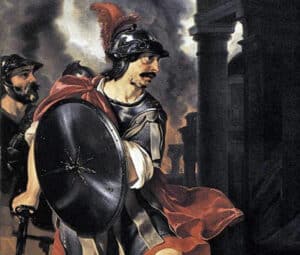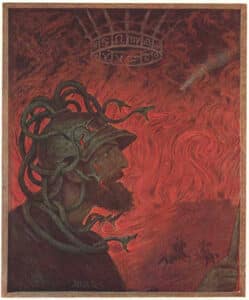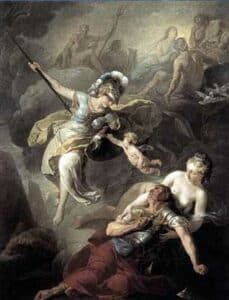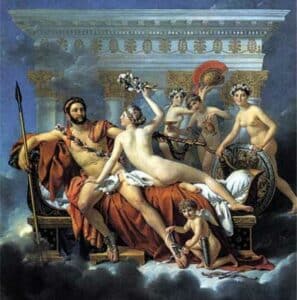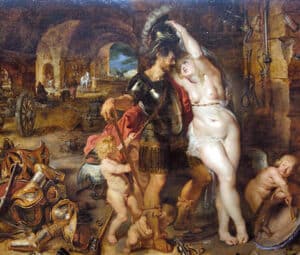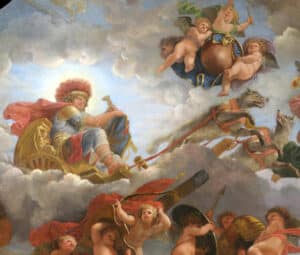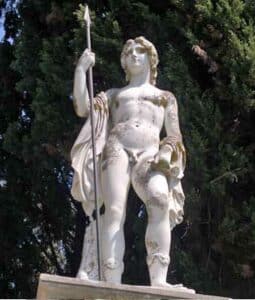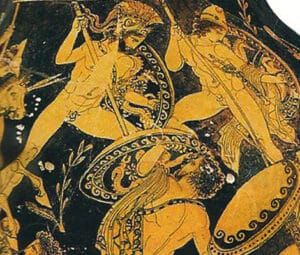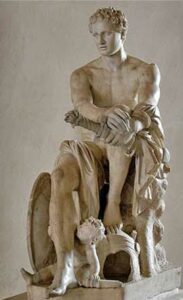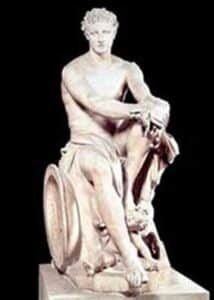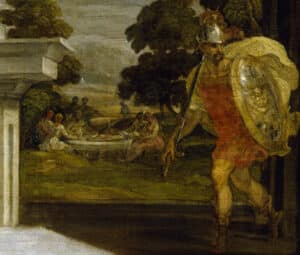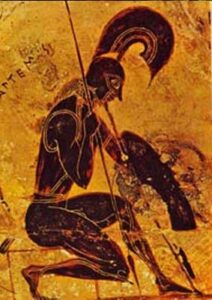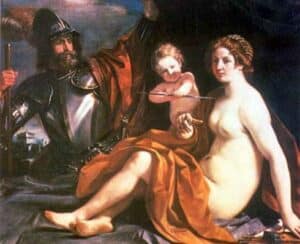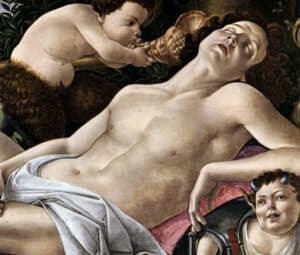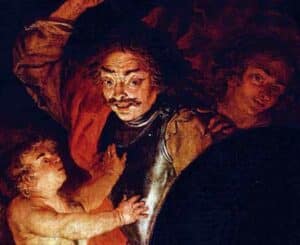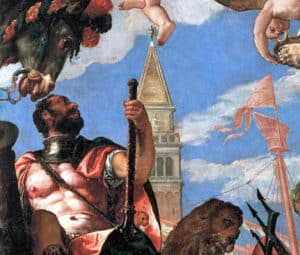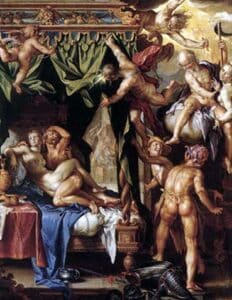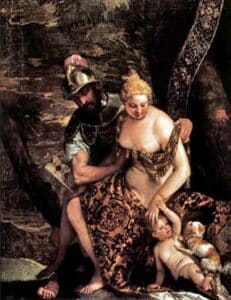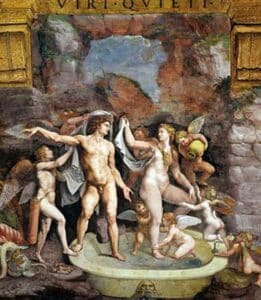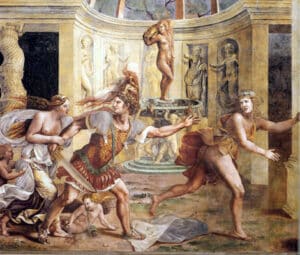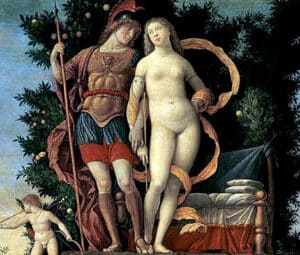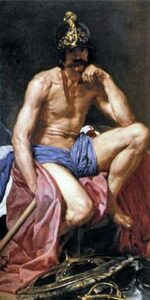Ares was the Olympian God of War, Violence, Rage, and Fear, as well as Courage and Civil Order. He was a feared God who lived for battle. Because of his destructive nature, the Ancient Greeks despised him. All of his prominent symbols were military in nature: a spear, a sword, a shield, a helmet, and, of course, his chariot.
Key Facts
Family tree
| Parents | Zeus and Hera |
| Partner(s) | Aphrodite, Aerope, Astyoche, Demonice, Eos, Persephone, Phylonome, Tanagra, Telphusia, Rhea Silvia |
| Siblings | Aphrodite, Apollo, Artemis, The Great Huntress, Athena, Dionysus, the god of wine and revelry, Hermes, God of All Trades, Aeacus, Angelos, Eileithyia, Enyo, Eris, Ersa, Hebe, Helen, The Most Beautiful Woman In The World, Hephaestus, Heracles, The Strongest Hero, Minos, Pandia, Persephone, Perseus, The Legendary Slayer of Medusa, Rhadamanthus, the Charites (Graces), The epitome of charm and beauty, the Horae, the Litae, the Muses, The Divine Inspirations Behind Art, Science, and Culture, the Moirai, Spinners of The Thread of Life |
| Offspring | Immortal: Eros, the Greek God of love, Anteros, Harmonia, Nike, Deimos, Phobos, Enyalios Mortal: Aeropos, Alcippe, the Amazons, Antiope, Ascalaphus, Diomedes, Dryas, Euenos, Hippolyte, Ialmenos, Cycnus, Licymnius, Lycastus, Lycus, Melanipos, Meleagros, Molos, Nisos, Oiagros, Oinomaus, Oxylos, Parrhasios, Panthenopaios, Penthesileia, Phlegyas, Porthaon, Pylos, Remus, Romulus, Tereus, Thestios, Thrassa |
Names & Others
| Roman Name | Mars |
| Other Names | Enyalios |
| Ancient Greek | Ἄρης |
| The God of | War, Civil Order, Battlelust, Fear and Courage, Violence and Rage |
| Symbols | Helmet, Shield, Spear, Sword |
Name and Etymology
There are many possible derivations of the name Ares. It is possible that it comes from a Pre-Greek origin, or that it was an abstract noun used to denote “battle, war”. Its earliest form however is the Linear B a-re, which is much like the actual name. The best known theory however on the God’s name connects it with the word ἀρή or ἀρά, meaning “curse” or “ruin”.
His name set to become an epithet, Areios, that described other Gods (like Zeus, Athena, or even Aphrodite) when they became involved in a war. Homer went so far as to make the name Ares synonymous with “battle” in the Iliad.
A common epithet of Ares was Enyalios. This God is sometimes considered to be the same as Ares, whereas sometimes he is thought of as a different war god, from a separate cult.
The Egyptians affiliated him with Horus and the Romans with Mars. However, both Horus and Mars were less aggressive than Ares and much more disciplined, while Ares was often associated with absolute chaos and sheer violence. His Norse equivalent is possibly Týr, but he was a more civilized god.
Ares’ Origins and Family
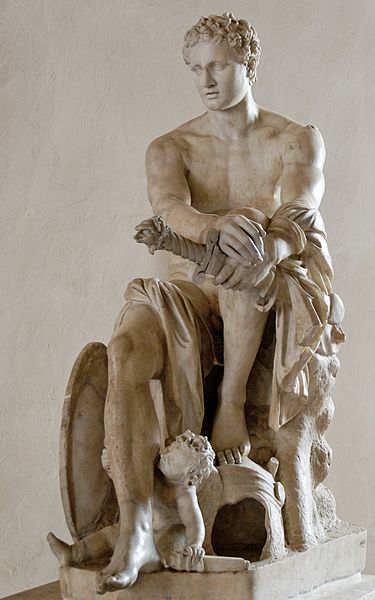
Ares is the son of Zeus and Hera and as such one of the Olympians. Following the myth that Hephaestus is born from Hera through Parthenogenesis, Ares is the only son of Zeus and Hera. The divine couple also had two daughters, Eileithyia, the goddess of childbirth, and Hebe, the goddess of youth.
Not much is known about Ares’ childhood years and relationship with his parents. However, in the Iliad, Zeus expresses his revulsion towards Ares. He actually goes all the way to characterize him as “the most hateful of all Olympians”.
The Greeks associated him with people from Thrace. They were, just as the god himself, considered to be warlike and savage.
Ares’ Lovers
Aphrodite, the goddess of love, was the God’s most famous consort. He also had several other, minor love affairs.
Ares’ Affair with Aphrodite
The most popular version of the two Olympians’ love affair begins with Ares falling in love with Aphrodite, but losing her to Hephaestus. Zeus married Aphrodite off to Hephaestus because the smith God had entrapped his mother, Hera, to exact revenge.
However, that did not stop the two lovebirds. Aphrodite had an extramarital relationship with the God of War. As a result, Hephaestus discovered the truth after Helios, the sun god informed him that he had seen them in their marital bed. Therefore, to take revenge on his wife and her lover, he bound them on that same bed. Hephaestus then made the other Olympians laugh at the entrapped gods.
Aphrodite fled to Paphos, and Ares to Thrace, filled with shame. Throughout Greek literature, however, the couple appeared to be together (the Iliad, for instance). Depending on the myth, they also had three to eight children.
Divine and Semi-Divine Loves
Apart from Aphrodite, no other of his earlier or later relationships were of much importance. He had a relationship with the following goddesses and Nymphs, Guardians of Nature:
- Cyrene, a Thracean nymph
- Eos, the goddess of Dawn, cursed with rampant sexuality by Aphrodite
- Enyo, the goddess of strife and war
- Erinys Telphousia, one of the Erinyes or a demonym of Demete, Goddess of Agriculture
- Harmonia, an Assyrian nymph (not to be confused with Aphrodite’s daughter)
- Harpinna, a Naiad from Elis
- Persephone was wooed by Ares, Apollo, and Hermes, before getting married to Hades
- Tanagra, a Naiad of Argos for whom Hermes and Ares fought over, and Hermes won
- Tereine, a Naiad from Thrace
- Triteia, a sea nymph from Akhaia
Mortal Loves
Some mortal women as well were said to have an affair with the God of War. None of these relationships are important enough, so we are just going to briefly mention them:
- Aerope, an Aetolian princess
- Aglauros, a princess from Attica
- Althaea, an Aetolian queen, wife of King Oineus
- Astyoche, a princess of Orchomenos
- Atalanta, an Arcadian princess, and huntress
- Ilia or Rhea Silvia, a princess of Latium and Vestal Virgin
- Otrera, a queen of the Amazons
- Pelopia, a Thessalian or Macedonian woman
- Phylonome, an Arcadian princess
- Protogeneia, an Aetolian princess
- Pyrene, a Macedonian woman – probably the same person as Cyrene
Ares’ Offspring
Although Ares was not frequently mentioned in Ancient Greek myths, he is genealogically connected to multiple children. However, his paternity was frequently assigned as an emphasis on a warlike or savage nature.
All of his divine offspring were children of Aphrodite, whereas his mortal offspring were attributed to various mothers.
Immortal Children
Ares actually had several children with Aphrodite before their sordid affair was broken off. Hesiod mentions three children: Deimos, the god of fear, Phobos, the god of panic as well as Harmonia, the goddess of harmony.
Later Roman writers, such as Nonnus, describe a few more children: Eros, the god of love, Anteros, the god of reciprocal love, Enyalios, a warlike god, and Nike, the goddess of victory.
Mortal Children
As previously stated, paternity may be attributed to Ares to emphasize the people’s brutal and warlike nature.
The earth-born warriors (also known as “Sparti”) were infamous God’s children who were said to have spawned fully-grown from the soil, from Dracon’s teeth sown into the earth.
Some of his children are:
- Alcippe, an Athenian girl, daughter of Agraulos; she was raped by Hallirhothios, Ares killed him, and later, he was accused of murder at the courthouse of Areios Pagos
- Amazons, the warrior women of Assyria, daughters of Harmonia
- Antiope, an Amazonian princess, daughter of Otrere; Theseus, The Founding Hero Of Athens had abducted her in the search of the golden belt
- Ascalaphus and Ialmenus, kings of Orkhomenos, and sons of Astyoche; they led their people during the Trojan war; Ares mourned Ascalaphus gravely when he died during the war
- Diomedes, a Thracean King, and son of Cyrene; later killed by Heracles
- Euenos, an Aetolian lord, son of Demonece or Sterope
- Hippolyte, an Amazonian queen, and daughter of Otrere; she was later killed by Heracles in the quest for the golden belt
- Lycastus, an Arcadian lord, son of Phylonome
- Lycus, a Libyan king; he used to sacrifice people from other areas for his father
- Melannipus, founder of Triteia, Achaia, son of Triteia
- Parthenopaeus, an Arcadian prince, son of Atalanta
- Penthesileia, an Amazonian queen, and daughter of Otrere; she led the Amazons in the Trojan war, but was killed by Achilles, The Mightiest Champion of The Trojan War; Ares mourned her gravely
- Phlegyas, a Thessalian king, son of Dotis or Chryse
- Pylos, an Aetolian lord, son of Demonice
- Remus and Romulus, kings of Latium, sons of Ilia (Rhea Silvia); then later the founders of Rome
- Thestios, an Aetolian lord, son of Demonice
- Thrassa, a Thracean queen, daughter of Tereine
Depiction and Characteristics
Ares was the only Olympian God who was truly despised. Even Hades, the God of the Underworld, was feared but not loathed in the same way that Ares was. He was a warlike, bloodthirsty God who was always depicted as a warrior.
Ares’ Appearance
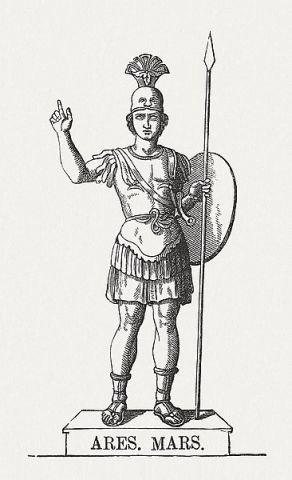
Ares was depicted as a fearsome warrior. He was represented as either a mature warrior, fully clothed and armed for battle or as a young, naked young man with curly hair holding his weapon equipment. He was dressed in red and purple as a symbol of blood.
Ares’ Personality
The God of War was detested by all. He was despised for his cruelty as well as his quick temper. Ares was a brawler who was always first in line for a fight. He was, also, unconcerned about people’s well-being. His only joy was in the slaughter and sheer brutality of war. As such he is a nefarious figure from Greek mythology, as well as closely associated with bloodlust.
However, it is important to note that Ares is the only Olympian God who has never forced himself on a woman. Furthermore, despite his flaws, he was always a good parent. He sought vengeance on anyone who harmed his children, vowed to protect them, came to their aid even after Zeus forbade it, and was absolutely devastated when they died in the war.
Finally, unlike other Gods who switched sides frequently, Ares was always on the side of those he favored, such as the Trojans.
Ares’ Powers
Ares, like the other Olympians, was all-powerful. Thus, he possessed superhuman strength and endurance, enhanced senses, omnipresence, shape-shifting abilities, and invulnerability.
However he also possessed the power of odikinesis as the God of War. It suggests that Ares has the ability to manipulate people, conflicts, and battles at his will. In this regard he had a lot of similarities to the Norse god of war Odin. He had the ability to influence all types of conflicts and their progression, as well as to incite chaos and war at any time.
The god was also skilled with martial weapons and combat techniques. He was a genius and a war master, skilled in all forms of warfare.
Ares’ Sacred Symbols
It stands to reason that the sacred symbols of the God of War are his military equipment. As a result, his sword, spear, shield, and armor were all considered to be part of the God’s estate. His chariot and palace were also both sacred symbols in a way.
Ares’ Sacred Animals / Plants
Ares had no sacred plants, which makes sense for the God of War. He did, however, have a few sacred animals, according to Antoninus Liberalis. The eagle-owl, barn-owl, and vulture were all birds of bad omen associated with the God. Vultures, in particular, were associated with the bloodthirsty God because they fed on dead bodies in battle. Aside from that, he is associated with the woodpecker, which was – surprisingly – thought to be a good-luck bird.
The poisonous snake, also known as “dracon,” is the animal most closely associated with the God. Most of Ares’ groves were guarded by these creatures, and he is frequently depicted in art with a serpent wrapped around him.
Ares’ Roles and Responsibilities
Ares was the God of Battle and War. He ruled over armies and battlefields. In some ways however, he could be considered the god of peace as well, as he would sometimes act to keep wars at bay. He presided over troop formation and rallying.
The God was so closely associated with war that his name became a synonym for warfare. He was personally present at the battlefield, often accompanied by three other gods. They were Phobos (the god of fear) and Deimos (the god of terror) as well as Eris (the goddess of hatred and strife).
Ares was also involved in city defense. He was revered as both the keeper of civil order and the patron of police forces, as well as the god of riots and civil disturbance. He is also the god of rage, murder, and courage, as well as its polar opposites, fear, and cowardice.
He was also revered as an ancestral god and protector of the motherland. Especially for Thebes, whose ancestors were thought to be Spartian warriors, sons of Ares – despite the fact that he turned Kadmos, King of Thebes, into a serpent.
Play Ares’ Games
Are you a good shooter like Ares? Play this game to find out!
You can also play around with Ares’ and other Olympian gods’ names in this fun anagram game:
Play our other games to test your skills and knowledge! For example, this fun image reveal game!
Myths About Ares
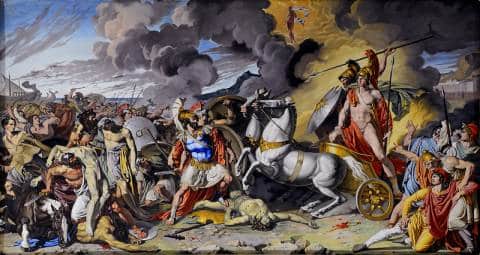
The majority of Ares’ myths revolve around his involvement in battle and warfare. Of course, his affair with Aphrodite is one of the most important and well-known myths about his life. Since we mentioned it earlier, we will now move on with the rest of the myths.
Fight With Hercules
Ares had several clashes with his brother Heracles. He was defeated by Hercules during the battle of Pylos and after Hercules murdered his son, Cycnus. During his labors, Heracles also killed King Diomedes and Antiope, both children of the god of war.
The Trojan War
The Beginning
During the Trojan War, Ares played a more important role than his siblings. Following the wedding of Peleus and Thetis, a sea nymph, where Paris granted Aphrodite the golden apple of Eris, Athena and Hera took opposing sides to Aphrodite. Athena and Hera supported the Greeks and initially persuaded Ares to join them. However, Aphrodite, the God’s lover, persuaded him to support the Trojans, which he did until the end.
Ares during the War
Ares rallies and leads the Trojan troops in Homer’s Iliad, whereas Athena leads the Greeks. Athena wounded the warrior God and later drove him away from the battlefield with Diomedes’ help (not to be confused with Ares’ son). In a later scene, Achilles murders Ascalaphus, and Ares wishes to go down and mourn his son, but Athena prevents him. Not only that, but his daughter Penthesileia, a warrior Amazon princess, is killed in battle, causing Ares to mourn two of his beloved children at the same time.
Toward the end, Ares tries to aid the Trojans in their fight against the Greeks, even attempting to destroy the Trojan Horse. Athena begins a fight with Ares, Zeus intervenes however, the Gods are instructed to leave Troy, and the city falls.
The Amazons
The Amazons were powerful warrior princesses who were Ares’ daughters. Throughout history, the god has been by their side. In her battles with Phrygia, Lykia, and other kingdoms, he also always fought alongside Queen Hippolyte. He had also offered his daughter a golden girdle, which was to be the cause of her death, as Hercules was to kill her and steal the girdle from her. Ares also supported his other daughter, Queen Penthesileia, during the Trojan War.
The Favors of The Unloved God
Despite being a universally despised God, Ares did some good for various people. During the war, he supported not only the Amazons and Trojans, but also the Brygi, Illyrians, Phlegyans, and Pylians.
As previously stated, he was usually protective of his family. He aided many of his children, including Diomedes, Hippolyte, Cycnus, Nisos, Oenomaus, Penthesileia, Phlegyas, and Polyphontes, as well as her half-bear sons, on numerous occasions.
Finally, Ares gave Aeetes a Draco to help him keep and guard his infamous Golden Fleece in Colchis, The Enchanted Land of the Golden Fleece.
Ares in Ancient Greek Religion
Ares was an unpopular God in Ancient Greece. However, he was revered in many different places, some more militaristic than others, such as Sparta, or because he was considered their ancestor, such as Thebes.
Sites Sacred to Ares
The Temple of Ares in Athens’ Ancient Agora is the best known sacred site to the God. Today however, only ruins can be found there. Temples to the God could also be found in Crete, Argos, Erythrae, Megalopolis, Olympia, Tegea, and Troezen.
The major courthouse in Greece, Areopagus, is named after the God. It is still known by the same name today.
Worship & Festivals
There were only a few festivals dedicated to the God because of his nature. Traditionally, soldiers offered sacrifices to him prior to the battle. Apart from Sparta, his cult was centered in Thessaly and Thrace. Pausanias mentions a few festivals, including one in the town of Geronthrai, near Sparta.
Representations of Ares in Art
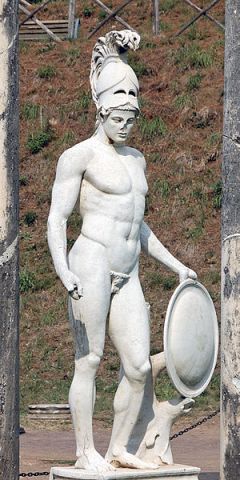
Ares was frequently depicted as a handsome young man, either naked or armored. He is often difficult to identify because he was not depicted with distinguishing characteristics in classical sculptures. Actually, the sculptures depicting Ares could be easily portraying a simple warrior.
The God is more frequently depicted on vases, either riding his chariot or fighting Heracles. He is also sometimes depicted holding his sacred animal, the serpent.
In his Roman form as Mars, he was far more popular. His love for Aphrodite, in particular, piqued the interest of artists such as “Mars and Venus” (S. Botticelli, 1485). Of course, the god could only be associated with warfare’s violence, as in “The Horrors of War” (Rubens, 1637).
In The Old Texts
Ares is frequently mentioned in various classical texts as the personification of war and violence. A large portion of Homer’s “Iliad” revolves around him and his assistance to the Trojans as well as his conflict with Athena. Homer’s “Odyssey,” on the other hand, is a fantastic source for Ares and Aphrodite’s erotic affair. In addition, the Homeric Hymns contain a few flattering verses about the God.
His love affairs and other myths surrounding the God of War’s life and works are frequently mentioned by Ovid, Virgil, and Statius.
FAQs
Ares was the god of war, violence, rage and battlelust, however he was also the god of peace, and civic order.
Zeus and Hera.
Phobos, Deimos, and Eris used to accompany the God on the battlefield.
His sword, his shield, his spear, and his helmet.
Ares is commonly associated with Týr.
Sources
Nonnus
- Dionysiaca 5.67, 41.339
Orphics
- Orphic Hymn 65 to Ares
Ovid
- Metamorphoses 4.170
Pausanias
- Description of Greece
Virgil
- Aeneid 1.273
Featured Image Credit: Johann Heiss, Public domain, via Wikimedia Commons

